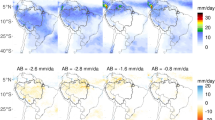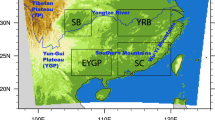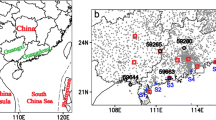Abstract
Mesoscale convective systems (MCSs) around the second-step terrain (106°–113°E, 28°–35°N), along the middle reaches of the Yangtze River, were detected, tracked and classified using a black body temperature (TBB) dataset during May to August 2000–2016 (except 2005). The MCSs were divided into eastward-propagating (EP) and quasi-stationary (QS) types, to compare their spatial and temporal distributions and convective intensities, and to identify the favorable synoptic conditions for the formation and evolution of EP MCSs. The results showed that both MCS types occurred most often in July. The EP MCSs were mainly initiated over the eastern regions of the study area, while the QS type mainly originated in the western regions of the study area. Both MCS types mainly formed in the afternoon, but a second peak occurred in the early morning for QS MCSs. The EP MCSs had a larger cloud area at their mature stage and a lower cloud brightness temperature, indicating more intense convection. Additionally, the longer lifetime and further eastward propagation of the EP MCSs meant that they had a great influence on the precipitation over the middle and lower reaches of the Yangtze River. Synoptic circulation analysis demonstrated that the combination of the mid-level low trough east of the Tibetan Plateau (TP), and the western pacific subtropical high (WPSH), favored the formation and eastward propagation of EP MCSs. The positive vertical relative vorticity and stronger vertical wind shear provided dynamic conditions favorable for convective organization and development. Furthermore, a stronger low level jet imported warm and moist air to the eastern edge of, and the regions east of, the second-step terrain. The substantial convergence of water vapor promoted the development and long-lived maintenance of the EP MCSs.
Similar content being viewed by others
References
Ai Y F, Li W B, Meng Z Y, Li J. 2016. Life cycle characteristics of MCSs in middle east China tracked by geostationary satellite and precipitation estimates. Mon Weather Rev, 144: 2517–2530
Anderson C J, Arritt R W. 1998. Mesoscale convective complexes and persistent elongated convective systems over the United States during 1992 and 1993. Mon Weather Rev, 126: 578–599
Augustine J A, Caracena F. 1994. Lower-tropospheric precursors to nocturnal MCS development over the central United States. Weather Forecast, 9: 116–135
Augustine J A, Howard K W. 1988. Mesoscale convective complexes over the United States during 1985. Mon Weather Rev, 116: 685–701
Augustine J A, Howard K W. 1991. Mesoscale convective complexes over the United States during 1986 and 1987. Mon Weather Rev, 119: 1575–1589
Bai A J, Liu X D, Liu C H. 2011. Contrast of diurnal variations of summer precipitation between the Tibetan Plateau and Sichuan Basin (in Chinese). Plateau Meteorol, 30: 852–859
Bluestein H B, Jain M H. 1985. Formation of mesoscale lines of pirecipitation: Severe squall lines in Oklahoma during the spring. J Atmos Sci, 42: 1711–1732
Chang C H, Ding Z Y. 2015. Distribution characteristics of MCCs in eastern Tibetan Plateau in summer from 2007 to 2012 (in Chinese). J Meteorol Sci, 35: 445–453
Chen Q, Fan J, Hagos S, Gustafson Jr W I, Berg L K. 2015. Roles of wind shear at different vertical levels: Cloud system organization and properties. J Geophys Res-Atmos, 120: 6551–6574
Coniglio M C, Hwang J Y, Stensrud D J. 2010. Environmental factors in the upscale growth and longevity of MCSs derived from rapid update cycle analyses. Mon Weather Rev, 138: 3514–3539
Coniglio M C, Stensrud D J, Wicker L J. 2006. Effects of upper-level shear on the structure and maintenance of strong Quasi-Linear mesoscale convective systems. J Atmos Sci, 63: 1231–1252
Cotton W R, Lin M S, McAnelly R L, Tremback C J. 1989. A composite model of mesoscale convective complexes. Mon Weather Rev, 117: 765–783
Delonge M S, Fuentes J D, Chan S, Kucera P A, Joseph E, Gaye A T, Daouda B. 2010. Attributes of mesoscale convective systems at the land-ocean transition in Senegal during NASA African monsoon multidisciplinary analyses 2006. J Geophys Res, 115: D10213
Durkee J D, Mote T L. 2010. A climatology of warm-season mesoscale convective complexes in subtropical South America. Int J Climatol, 30: 418–431
Fu W, Wang D H, Yin H, Yin J F, Li J. 2013. Contrast analysis on statistical characteristic of MCSs over Qinghai-Xizang Plateau and East Asia in warm season (in Chinese). Plateau Meteorol, 32: 929–943
Goyens C, Lauwaet D, Schröder M, Demuzere M, Van Lipzig N P M. 2012. Tracking mesoscale convective systems in the Sahel: Relation between cloud parameters and precipitation. Int J Climatol, 32: 1921–1934
He H Z, Zhang F Q. 2010. Diurnal variations of warm-season precipitation over northern China. Mon Weather Rev, 138: 1017–1025
Hodges K I, Thorncroft C D. 1997. Distribution and statistics of African mesoscale convective weather systems based on the ISCCP Meteosat imagery. Mon Weather Rev, 125: 2821–2837
Houze R A. 2004. Mesoscale convective systems. Rev Geophys, 42: RG4003
Hu L, Deng D F, Gao S T, Xu X D. 2016. The seasonal variation of Tibetan convective systems: Satellite observation. J Geophys Res-Atmos, 121: 5512–5525
Hu M K. 1962. Visual pattern recognition by moment invariants. IEEE Trans Inform Theor, 8: 179–187
Jiang J X, Fan M Z. 2002. Convective clouds and mesoscale convective systems over the Tibetan Plateau in summer (in Chinese). Chin J Atmos Sci, 26: 263–270
Jirak I L, Cotton W R, McAnelly R L. 2003. Satellite and radar survey of mesoscale convective system development. Mon Weather Rev, 131: 2428–2449
Kidder S Q, Vonder Haar T H. 1995. Satellite Meteorology: An introduction. San Diego: Academic Press
Laing A G, Fritsch J M. 1997. The global population of mesoscale convective complexes. Q J R Met Soc, 123: 389–405
Li J. 2010. Study on the characteristics of the mesoscale convective cloud clusters occurred in East Asia during warm seasons (in Chinese). Dissertation for Doctoral Degree. Beijing: Institute of Atmospheric Physics, Chinese Academy of Sciences. 1–154
Li J Y, Shen X Y, Wang D H, Li J. 2015. Distribution and characteristics of the MCS over south China during the spring and summer of 2008 (in Chinese). J Trop Meteorol, 31: 475–485
Li J, Wang B, Wang D H. 2012. The characteristics of mesoscale convective systems (MCSs) over East Asia in warm seasons. Atmos Ocean Sci Lett, 5: 102–107
Liu R X, Ding Z Y, Sun L G, Huang H B. 2015. Statistical analysis of mesoscale convective systems over Yangtze-Huaihe basin in summer (in Chinese). Torr Rain Disast, 34: 215–222
Lu X R, Ma J, Wu C K. 1987. A Shape analytical method of two dimensional objects (in Chinese). J China Inst Commun, 8: 61–67
Maddox R A. 1980. Meoscale convective complexes. Bull Amer Meteorol Soc, 61: 1374–1387
Maddox R A. 1983. Large-scale meteorological conditions associated with midlatitude, mesoscale convective complexes. Mon Weather Rev, 111: 1475–1493
Mathon V, Laurent H. 2001. Life cycle of Sahelian mesoscale convective cloud systems. Q J R Met Soc, 127: 377–406
McAnelly R L, Cotton W R. 1992. Early growth of mesoscale convective complexes: A meso-β-scale cycle of convective precipitation? Mon Weather Rev, 120: 1851–1877
Meng Z Y, Yan D C, Zhang Y J. 2013. General features of squall lines in east China. Mon Weather Rev, 141: 1629–1647
Merritt J H, Fritsch J M. 1984. On the movement of the heavy precipitation areas of mid-latitude mesoscale convection complexes. Clearwater Beach: Conference on Weather Forecasting and Analysis. 529–536
Moncrieff M W. 1992. Organized convective systems: Archetypal dynamical models, mass and momentum flux theory, and parametrization. Q J R Met Soc, 118: 819–850
Nicolini M, Torres Brizuela M. 2002. Sensitivity of a two-dimensional convective model to turbulence parameterization. Atmósfera, 15: 193–207
Ogungbenro S B, Ajayi V O, Adefolalu D O. 2016. Mean state and kinematic properties of mesoscale convective systems over West Africa. Theor Appl Climatol, 124: 219–227
Parker M D, Johnson R H. 2000. Organizational modes of midlatitude mesoscale convective systems. Mon Weather Rev, 128: 3413–3436
Pope M, Jakob C, Reeder M J. 2008. Convective systems of the north Australian monsoon. J Clim, 21: 5091–5112
Punkka A J, Bister M. 2015. Mesoscale convective systems and their synoptic-scale environment in Finland. Weather Forecast, 30: 182–196
Qi X X, Zheng Y G. 2009. Distribution and spatiotemporal variations of deep convective over China and its vicinity during the summer of 2007 (in Chinese). J Appl Meteorol Sci, 20: 286–294
Rafati S, Karimi M. 2017. Assessment of mesoscale convective systems using IR brightness temperature in the southwest of Iran. Theor Appl Climatol, 129: 539–549
Rasmussen K L, Houze Jr R A. 2011. Orogenic convection in subtropical South America as seen by the TRMM satellite. Mon Weather Rev, 139: 2399–2420
Richardson Y P, Droegemeier K K, Davies-Jones R P. 2007. The influence of horizontal environmental variability on numerically simulated convective storms. Part I: Variations in vertical shear. Mon Weather Rev, 135: 3429–3455
Romatschke U, Houze Jr R A. 2010. Extreme summer convection in South America. J Clim, 23: 3761–3791
Rotunno R, Klemp J B, Weisman M L. 1988. A theory for strong, longlived squall lines. J Atmos Sci, 45: 463–485
Rowell D P, Milford J R. 1993. On the generation of African squall lines. J Clim, 6: 1181–1193
Salio P, Nicolini M, Zipser E J. 2007. Mesoscale convective systems over southeastern South America and their relationship with the South American low-level jet. Mon Weather Rev, 135: 1290–1309
Schröder M, König M, Schmetz J. 2009. Deep convection observed by the Spinning Enhanced Visible and Infrared Imager on board Meteosat 8: Spatial distribution and temporal evolution over Africa in summer and winter 2006. J Geophys Res, 114: D05109
Schumacher R S, Johnson R H. 2005. Organization and environmental properties of extreme-rain-producing mesoscale convective systems. Mon Weather Rev, 133: 961–976
Sun J H, Zhang F Q. 2012. Impacts of mountain-plains solenoid on diurnal variations of rainfalls along the mei-yu front over the east China plains. Mon Weather Rev, 140: 379–397
Sun J H, Zhang X L, Qi L L, Zhang G Y, Zhao S X, Tao S Y. 2004. An analysis on MCSs in Meiyu front during 20-24 June 2002 (in Chinese). Acta Meteorol Sin, 62: 423–438
Tollerud E I, Augustine J A, Jamison B D. 1992. Cloud top characteristics of mesoscale convective systems in 1986. Atlanta: Conference on Satellite Meteorology and Oceanography. J3–J7
Tollerud E I, Collander R S. 1993. Mesoscale convective systems and extreme rainfall in the central United States. Iahs Publication. 11-11
Tomasini M, Lafore J P, Piriou C, Rock R, Ramage K, Laurent H, Morel C, Senesi S. 2006. Atlas on a climatology of West African mesoscale convective systems. AMMA European Deliverable
Trier S B, Parsons D B. 1993. Evolution of environmental conditions preceding the development of a nocturnal mesoscale convective complex. Mon Weather Rev, 121: 1078–1098
Velasco I, Fritsch J M. 1987. Mesoscale convective complexes in the Americas. J Geophys Res, 92: 9591–9613
Weisman M L, Rotunno R. 2004. “A theory for strong long-lived squall lines” revisited. J Atmos Sci, 61: 361–382
Xu K M, Arakawa A, Krueger S K. 1992. The macroscopic behavior of cumulus ensembles simulated by a cumulus ensemble model. J Atmos Sci, 49: 2402–2420
Yang X R, Fei J F, Huang X G, Cheng X P, Carvalho L M, He H R. 2015. Characteristics of mesoscale convective systems over China and its vicinity using geostationary satellite FY2. J Clim, 28: 4890–4907
Zeng B, Chen Y, Li Z C. 2016. Characteristic of precursor environment of mesoscale convective system during summer in central-eastern China (in Chinese). Plateau Meteorol, 35: 460–468
Zhang Y C, Sun J H. 2017. Comparison of the diurnal variations of precipitation east of the Tibetan Plateau among sub-periods of Meiyu season. Meteorol Atmos Phys, 129: 539–554
Zhang Y C, Zhang F Q, Davis C A, Sun J H. 2018. Diurnal evolution and structure of long-lived mesoscale convective vortices along the Mei-yu front over the East China Plains. J Atmos Sci, 75: 1005–1025
Zheng L L, Sun J H, Zhang X L, and L C H. 2013. Organizational modes of mesoscale convective systems over central East China. Weather Forecast, 28: 1081–1098
Zheng L L, Sun J H. 2013. Characteristics of synoptic and surface circulation of mesoscale convective systems in dry and moist environmental conditions (in Chinese). Chin J Atmos Sci, 37: 891–904
Zheng L L, Sun J H. 2016. The impact of vertical wind shear on the intensity and organizational mode of mesoscale convective systems using numerical experiments (in Chinese). Chin J Atmos Sci, 40: 324–340
Zheng Y G, Chen J, Zhu P J. 2008. Climatological distribution and diurnal variation of mesoscale convective systems over China and its vicinity during summer. Chin Sci Bull, 53: 1574–1586
Zheng Y G, Xue M, Li B, Chen J, Tao Z Y. 2016. Spatial characteristics of extreme rainfall over China with hourly through 24-hour accumulation periods based on national-level hourly rain gauge data. Adv Atmos Sci, 33: 1218–1232
Zhuo H, Zhao P, Li C H, Pu Z X. 2012. Analysis of climatic characteristics of mesoscale convective system over the lower reaches of the Yellow River during summer (in Chinese). Chin J Atmos Sci, 36: 1112–1122
Zipser E J, Cecil D J, Liu C T, Nesbitt S W, Yorty D P. 2006. Where are the most intense thunderstorms on earth? Bull Amer Meteorol Soc, 87: 1057–1072
Acknowledgements
This research was supported by the National Key R & D Program of China (Grants No. 2018YFC1507200), and the National Natural Science Foundation of China (Grants Nos. 41505038, 91637211, 41775046 & 41575045).
Author information
Authors and Affiliations
Corresponding author
Rights and permissions
About this article
Cite this article
Yang, R., Zhang, Y., Sun, J. et al. The comparison of statistical features and synoptic circulations between the eastward-propagating and quasi-stationary MCSs during the warm season around the second-step terrain along the middle reaches of the Yangtze River. Sci. China Earth Sci. 63, 1209–1222 (2020). https://doi.org/10.1007/s11430-018-9385-3
Received:
Revised:
Accepted:
Published:
Issue Date:
DOI: https://doi.org/10.1007/s11430-018-9385-3




